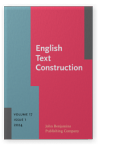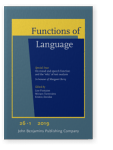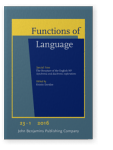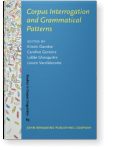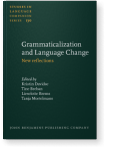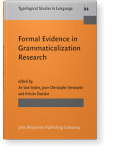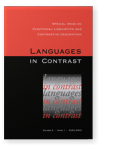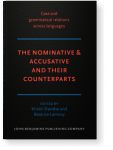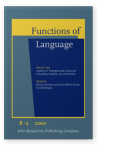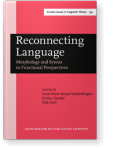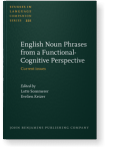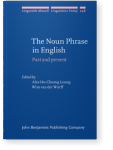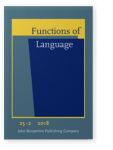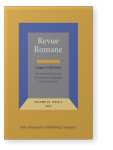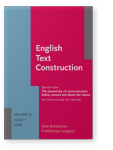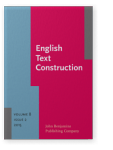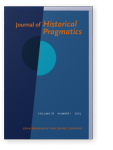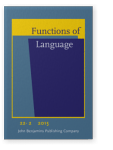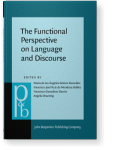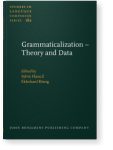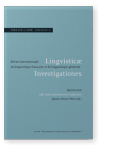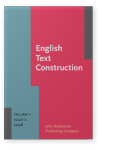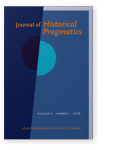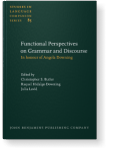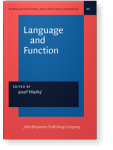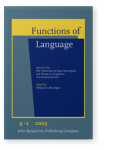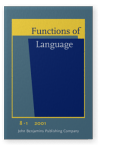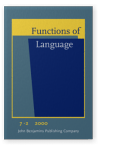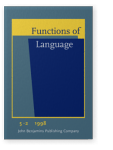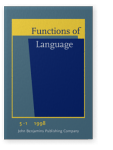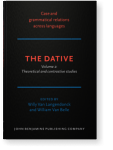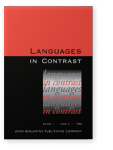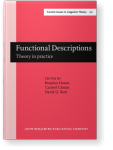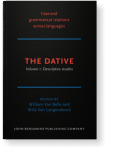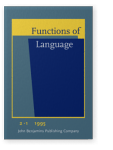Kristin Davidse
List of John Benjamins publications for which Kristin Davidse plays a role.
Journal
On mood and speech function and the ‘why’ of text analysis: In honour of Margaret Berry
Edited by Lise Fontaine, Miriam Taverniers and Kristin Davidse
Special issue of Functions of Language 26:1 (2019) vi, 135 pp.
Subjects Corpus linguistics | Discourse studies | Functional linguistics | Pragmatics | Theoretical linguistics
The Structure of the English NP: Synchronic and diachronic explorations
Edited by Kristin Davidse
Special issue of Functions of Language 23:1 (2016) v, 147 pp.
Subjects Corpus linguistics | Discourse studies | Functional linguistics | Pragmatics | Theoretical linguistics
Corpus Interrogation and Grammatical Patterns
Edited by Kristin Davidse, Caroline Gentens, Lobke Ghesquière and Lieven Vandelanotte
[Studies in Corpus Linguistics, 63] 2014. viii, 358 pp.
Subjects Corpus linguistics | Syntax | Theoretical linguistics
Grammaticalization and Language Change: New reflections
Edited by Kristin Davidse, Tine Breban, Lieselotte Brems and Tanja Mortelmans
[Studies in Language Companion Series, 130] 2012. viii, 342 pp.
Subjects Functional linguistics | Historical linguistics | Theoretical linguistics
Formal Evidence in Grammaticalization Research
Edited by An Van linden, Jean-Christophe Verstraete and Kristin Davidse
[Typological Studies in Language, 94] 2010. viii, 344 pp.
Subjects Historical linguistics | Syntax | Theoretical linguistics
Functional Linguistics and Contrastive Description
Edited by Kristin Davidse and Liesbet Heyvaert
Special issue of Languages in Contrast 4:1 (2004) 199 pp.
Subjects Comparative linguistics | Functional linguistics | Theoretical linguistics
The Nominative & Accusative and their counterparts
Edited by Kristin Davidse and Béatrice Lamiroy
[Case and Grammatical Relations Across Languages, 4] 2002. x, 363 pp.
Subjects Functional linguistics | Semantics | Syntax | Theoretical linguistics
Aspects of “Interpersonal Grammar”: Grounding, modality, and evidentiality
Edited by Kristin Davidse and Anne-Marie Simon-Vandenbergen
Special issue of Functions of Language 8:2 (2001) iv, 154 pp.
Subjects Functional linguistics | Pragmatics
Reconnecting Language: Morphology and Syntax in Functional Perspectives
Edited by Anne-Marie Simon-Vandenbergen, Kristin Davidse and Dirk Noël
[Current Issues in Linguistic Theory, 154] 1997. xiii, 339 pp.
Subjects Functional linguistics | Morphology | Syntax
2022 Refining and re-defining secondary determiners in relation to primary determiners English Noun Phrases from a Functional-Cognitive Perspective: Current issues, Sommerer, Lotte and Evelien Keizer (eds.), pp. 27–78 | Chapter
The aim of this study is to delineate the functional category of English secondary determiners more precisely than in current reference grammars and in my own previous work. To provide a principled basis for a functional typology of secondary determiners, I firstly develop a typology of primary… read more
2019 Introduction On mood and speech function and the ‘why’ of text analysis: In honour of Margaret Berry, Fontaine, Lise, Miriam Taverniers and Kristin Davidse (eds.), pp. 5–12 | Introduction
2019 English tag questions eliciting knowledge or action: A comparison of the speech function and exchange structure models On mood and speech function and the ‘why’ of text analysis: In honour of Margaret Berry, Fontaine, Lise, Miriam Taverniers and Kristin Davidse (eds.), pp. 86–111 | Article
2018 Chapter 2. Complex NPs with third-order entity clauses: Towards a grammatical description and semantic typology The Noun Phrase in English: Past and present, Ho-Cheong Leung, Alex and Wim van der Wurff (eds.), pp. 11–46 | Chapter
This article focuses on complex NP constructions of the form ‘determiner (+ adjective) + noun (+ complementiser) + clause’, which refer to third-order entities, defined by Lyons (1977: 443) as “such abstract entities as propositions, which are outside time and space”. Their functional structure has… read more
2018 A tribute to M. A. K. Halliday (1925–2018) Functions of Language 25:2, pp. 205–228 | Obituary
2017 La duplicación de clíticos en español como estrategia de marcación inversa Revue Romane 52:2, pp. 190–206 | Article
Clitic doubling is the phenomenon in which, in a clause, a NP or a stressed pronoun and a clitic pronoun refer to the same entity and have the same syntactic function. Previous studies on this phenomenon in Spanish observe that it takes place when the elements involved have features such as… read more
2016 Introduction The Structure of the English NP: Synchronic and diachronic explorations, Davidse, Kristin (ed.), pp. 9–16 | Article
2016 Specificational there-clefts: Functional structure and information structure The dynamicity of communication below, around and above the clause, Clarke, Ben and Jorge Arús-Hita (eds.), pp. 115–142 | Article
In this article we present functional-structural and information structure arguments for recognizing specificational there-clefts, i.e. clefts that specify a value for a variable. We distinguish two types which hinge on whether the matrix is a listing or a canonical existential. Listing… read more
2016 Mirativity and rhetorical structure: The development and prosody of disjunct and anaphoric adverbials with ‘no’ wonder Outside the Clause: Form and function of extra-clausal constituents, Kaltenböck, Gunther, Evelien Keizer and Arne Lohmann (eds.), pp. 125–156 | Article
This paper studies from a synchronic-diachronic perspective the formal and semantic-discursive properties of adverbial expressions with a negative quantifier + wonder (henceforth ‘no’ wonder). They are used as mirative qualifiers which assess a proposition as ‘not surprising’, typically motivated… read more
2015 Conjunctive structures in learner English: A qualitative analysis of hortatory expositions English Text Construction 8:2, pp. 236–264 | Article
In this paper we address the issue of conjunction use in learner writing from a text-structuring angle, focusing on hortatory expositions by NNS learners and NS professionals. The learners are advanced Dutch-speaking students of English, while the professionals are journalists writing for British… read more
2015 The development of the modal and discourse marker uses of (there/it is/I have) no doubt Journal of Historical Pragmatics 16:1, pp. 25–58 | Article
In this paper, we reconstruct the emergence of the modal and discourse marker uses of adverbial and clausal expressions with no doubt. Their history contrasts in a number of surprising ways with typical grammaticalization hypotheses. Existential expressions with no doubt emerged directly with… read more
2015 Lexicalization and grammaticalization: The case of the verbo-nominal expressions be on the/one’s way/road Functions of Language 22:2, pp. 232–263 | Article
In this article we show that verbo-nominal expressions be on the/one’s way/road emerged as lexical composite predicates in Old English. These templates came to be elaborated by directional adjuncts, adjuncts describing states or events, and purpose clauses. In Late Modern English, the structure… read more
2014 Nominal reference and the dynamics of discourse: A cognitive-functional approach The Functional Perspective on Language and Discourse: Applications and implications, Gómez González, María de los Ángeles, Francisco José Ruiz de Mendoza Ibáñez, Francisco Gonzálvez-García and Angela Downing (eds.), pp. 189–208 | Article
In this paper I will address what appear to be some important gaps in the
traditional approach to nominal reference as a cohesion-creating resource:
(i) ignoring of relations other than co-referentiality, such as those expressed by
quantifying determiners, (ii) neglect of the contribution made by… read more
2014 Interrogating corpora to describe grammatical patterns Corpus Interrogation and Grammatical Patterns, Davidse, Kristin, Caroline Gentens, Lobke Ghesquière and Lieven Vandelanotte (eds.), pp. 1–11 | Article
2014 The speech functions of tag questions
and their properties. A comparison of their distribution in COLT and LLC Corpus Interrogation and Grammatical Patterns, Davidse, Kristin, Caroline Gentens, Lobke Ghesquière and Lieven Vandelanotte (eds.), pp. 321–350 | Article
This article proposes a classification of speech functions of variable tag questions in British English conversations. Based on intonational, conversational and formal criteria the analysis shows that tag questions can not only function as questions and statements, but also as responses, commands… read more
2014 The different developments of progressive aspect markers be in the middle/midst of and be in the process of V-ing: mechanisms of change Grammaticalization – Theory and Data, Hancil, Sylvie and Ekkehard König (eds.), pp. 181–202 | Article
In this case study, we reconstruct the grammaticalization paths of middle, midst and process, which led to a set of progressive aspect markers (PAMs) in Present-day English. The three PAMs developed from two different source structures, viz. complex prepositions in the middle/midst of + NP and… read more
2012 Introduction: New reflections on the sources, outcomes, defining features and motivations of grammaticalization Grammaticalization and Language Change: New reflections, Davidse, Kristin, Tine Breban, Lieselotte Brems and Tanja Mortelmans (eds.), pp. 1–36 | Article
2012 On ways of being on the way: Lexical, complex preposition and aspect marker uses International Journal of Corpus Linguistics 17:2, pp. 229–258 | Article
This article presents a case study of a set of constructions containing the related way-nouns road, way, track and route, exemplified by (i) the farm road to the house, (ii) A senior Soviet official is on his way to the Iraqi capital, (iii) spies Burgess and Maclean escaped from Britain en route to… read more
2010 Introduction Formal Evidence in Grammaticalization Research, Van linden, An, Jean-Christophe Verstraete and Kristin Davidse (eds.), pp. 1–16 | Article
2008 Cognate and locative complements: Their effect on (a)telicity and their semantic relation to the verb 25th Lexis and Grammar Conference, Mirto, Ignazio Mauro (ed.), pp. 256–272 | Article
2008 English middles with mental and verbal predicates: Towards a typology English Text Construction 1:2, pp. 169–197 | Article
In this article we investigate whether verbs of perception, affection, cognition and verbalization can be construed in the English middle voice against (at least partial) claims to the contrary such as Fellbaum (1986), Keyser and Roeper (1984), Quirk et al. (1985). We view the middle as a modal… read more
2008 Type noun uses in the English NP: A case of right to left layering International Journal of Corpus Linguistics 13:2, pp. 139–168 | Article
This article addresses the relatively neglected question of identifying and characterizing the various uses of sort, kind and type in the English NP. It does so on the basis of close analysis of a set of data extracted from the Times subcorpus of the COBUILD corpus. The proposed description refers… read more
2008 The interlocking paths of development to emphasizer adjective pure Journal of Historical Pragmatics 9:2, pp. 255–287 | Article
This study deals with the emphasizing use of adjective pure, as in pure heaven, pure unbridled hell, which heightens the semantic specifications of the following nominal description. On the basis of close analysis of synchronic and diachronic data, it is argued that the peculiarities of Present-day… read more
2007 Do cognate and circumstantial complements of intransitive verbs form one ‘Range’? A corpus-based discussion Functional Perspectives on Grammar and Discourse: In honour of Angela Downing, Butler, Christopher S., Raquel Hidalgo Downing and Julia Lavid-López (eds.), pp. 129–148 | Article
In this article we examine the question whether cognate complements (as in dance the tango) and circumstantial complements (as in climb stairs) can be regarded as expressing the same semantic role. Halliday has proposed that they do: in his view they both delimit the ‘extent’, or ‘Range’, of the… read more
2004 Introduction Functional Linguistics and Contrastive Description, Davidse, Kristin and Liesbet Heyvaert (eds.), pp. 1–12 | Miscellaneous
2003 FSP and the grammar of the weather in English Language and Function: To the memory of Jan Firbas, Hladký, Josef (ed.), pp. 71–88 | Article
2003 English locative constructions: An exercise in neo-Firthian description and dialogue with other schools The Interaction of Data, Description, and Theory in Linguistics: Functional perspectives, McGregor, William B. (ed.), pp. 169–207 | Article
In this article, we set out to describe the general ‘lexicogrammar’ of English locative constructions within a broadly neo-Firthian theoretical frame. First, we look at the question of how the verb and its participants — nominal and prepositional — are structurally integrated with each other. To… read more
2002 5. Nominative and oblique in English: Reflexive clauses as a test case for distinct Agent–Patient models The Nominative & Accusative and their counterparts, Davidse, Kristin and Béatrice Lamiroy (eds.), pp. 131–173 | Chapter
2002 1. Introduction The Nominative & Accusative and their counterparts, Davidse, Kristin and Béatrice Lamiroy (eds.), pp. 1–14 | Chapter
2001 Review of “Lexicogrammatical Cartography: English Systems” by Christian M.I.M. Matthiessen Functions of Language 8:1, pp. 162–168 | Miscellaneous
2001 Introduction Aspects of “Interpersonal Grammar”: Grounding, modality, and evidentiality, Davidse, Kristin and Anne-Marie Simon-Vandenbergen (eds.), pp. 175–181 | Miscellaneous
2000 Jan Firbas 1921-2000 Functions of Language 7:2, pp. 273–277 | Obituary
1998 The dative as participant role versus the Indirect Object: on the need to distinguish two layers of organization The Dative: Volume 2: Theoretical and contrastive studies, Van Langendonck, Willy and William Van Belle (eds.), pp. 143–184 | Article
1998 Introduction Languages in Contrast 1:2, pp. v–xi | Miscellaneous
1996 Ditransitivity and Possession Functional Descriptions: Theory in practice, Hasan, Ruqaiya †, Carmel Cloran and David Butt (eds.), pp. 85–144 | Article
1996 4.Functional dimensions of the dative in English The Dative: Volume 1: Descriptive studies, Van Belle, William and Willy Van Langendonck (eds.), pp. 289–340 | Chapter
1995 Anna Fuchs. Remarks on Deixis Functions of Language 2:1, pp. 125–126 | To be specified
1987 M.A.K. Halliday’s functional grammar and the Prague school Functionalism in Linguistics, Dirven, René † and Vilém Fried (eds.), pp. 39–80 | Article
